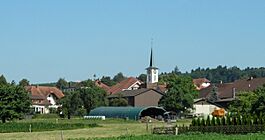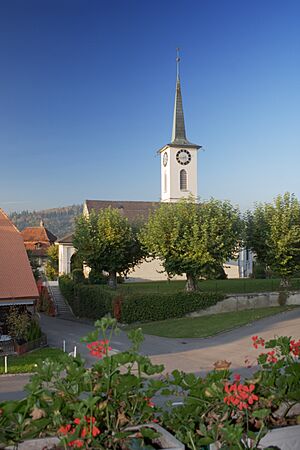Diessbach bei Büren facts for kids
Quick facts for kids
Diessbach bei Büren
|
||
|---|---|---|

Diessbach village
|
||
|
||
| Country | Switzerland | |
| Canton | Bern | |
| District | Seeland | |
| Area | ||
| • Total | 6.33 km2 (2.44 sq mi) | |
| Elevation | 464 m (1,522 ft) | |
| Population
(Dec 2020 )
|
||
| • Total | 991 | |
| • Density | 156.56/km2 (405.5/sq mi) | |
| Postal code |
3264
|
|
| Surrounded by | Schnottwil, Wengi, Grossaffoltern, Lyss, Büetigen, Dotzigen, Büren an der Aare | |
Diessbach bei Büren is a small town, also called a municipality, in Switzerland. It's located in the Seeland area of the canton of Bern.
Diessbach has a Reformed church. This church is important because it's the main church for a group of towns. These towns include Busswil bei Büren, Büetigen, and Dotzigen.
Contents
A Look at Diessbach's Past
People have lived in the Diessbach area for a very long time. The oldest signs of humans are from the Stone Age. This was when people used stone tools. Later, items from the Bronze Age were found. A special grave from the Iron Age, called the La Tène era, was also discovered.
During the time of the Roman Empire, there was a large farm here. Smaller settlements were also found in different spots.
The town's name, Diespah, first appeared in old writings in 1244. Back then, Diessbach was just a few farms and a church. This church was very old, possibly built around the 7th century.
In 1393, Diessbach became part of Bern. This happened because it was part of the Strassberg lands. Diessbach then joined the Büren an der Aare area, which became an official district in 1803.
The church building you see today was built in 1858-59. But it's not the first church on that spot! Five older churches stood there before it. The first church was mentioned as St. John's Church in 1244.
In the early 1800s, farmers in Diessbach started focusing on dairy cows. By 1830, there were two big dairies in the town. Today, Diessbach also has small factories. They make things like watch parts and parts for buildings. Even though there's no train station, many people travel to Lyss for work. Diessbach also has its own primary school for younger students.
Where is Diessbach?
Diessbach bei Büren covers an area of about 6.30 square kilometers (2.43 square miles). A large part of this land, about 59.6%, is used for farming. Forests cover about 32.2% of the area. The rest, about 7.8%, has buildings and roads.
Most of the forest is made up of thick, natural woods. For farming, people grow crops on 51.0% of the land. About 6.0% is used for pastures where animals graze. Another 2.5% is used for growing fruits or grapes.
The town is located at the northern edge of a forest called Oberwald. Diessbach bei Büren includes the main village and smaller areas. These smaller areas are called Angel, Eichi, and Hübeli.
In 2010, Diessbach became part of a new administrative area. This new area is called Verwaltungskreis Seeland.
Town Symbol (Coat of Arms)
The official description of Diessbach's coat of arms is: Gules a Triple Bend wavy fimbriated Sable. This means it has a red background with three wavy black stripes. These wavy stripes represent a stream or "bach" in German. This makes it a "canting arms", which means the symbol hints at the town's name.
Who Lives in Diessbach?
Diessbach bei Büren has a population of 991. About 6.8% of the people living here are from other countries. Over the last 10 years, the population has grown by about 6.2%. Most of this growth is from people moving into the town.
Most people in Diessbach speak German. About 97.3% speak German as their first language. A smaller number of people speak French (1.0%) or Albanian (0.6%).
In 2008, the population was almost evenly split between males and females. About 50.4% were male and 49.6% were female. Many people, about 32.4%, were born in Diessbach. Others were born in the same canton (42.9%) or elsewhere in Switzerland (16.1%). About 5.3% of the people were born outside Switzerland.
Young people, aged 0-19, make up about 24.7% of the population. Adults, aged 20-64, are the largest group at 59.9%. Seniors, over 64, make up 15.4%.
Most homes in Diessbach are lived in all the time. In 2010, new homes were being built at a good rate.
The chart below shows how the population of Diessbach has changed over time:

Jobs and Work
In 2011, Diessbach bei Büren had a low unemployment rate of 1.07%. This means most people who wanted jobs had them. In 2008, 250 people worked in the municipality.
Many jobs are in the primary sector. This means jobs like farming. There were 87 people working in this area. The secondary sector includes manufacturing and construction. About 78 people worked here. The tertiary sector includes jobs like sales, healthcare, and education. About 85 people worked in this sector.
Many people who live in Diessbach travel to other towns for work. About 325 people leave Diessbach for their jobs. Only 133 people come into Diessbach for work. Most workers (63%) use a private car to get to work. A smaller number (6.4%) use public transportation.
Religion
Based on a 2000 survey, most people in Diessbach are Christian. About 74.9% belong to the Swiss Reformed Church. Another 9.0% are Roman Catholic. A small number of people belong to other Christian churches (12.30%) or are Islamic (0.58%). About 5.68% of the population do not belong to any church.
Schools and Learning
Education is important in Diessbach. About 42.5% of the people have finished high school. About 10.0% have gone on to higher education, like university.
The Canton of Bern has a specific school system. Kids start with one year of optional Kindergarten. Then they go to six years of Primary school. After that, they have three years of lower Secondary school. In secondary school, students are grouped by their skills. After secondary school, students can continue their education or start an apprenticeship (learning a job while working).
In the 2009-10 school year, 107 students attended school in Diessbach. There was one kindergarten class with 19 students. The primary school had 4 classes and 72 students. The lower secondary school had one class with 16 students.
Some students from Diessbach also go to schools in other towns. In 2000, 47 students did this.
See also
 In Spanish: Diessbach bei Büren para niños
In Spanish: Diessbach bei Büren para niños





